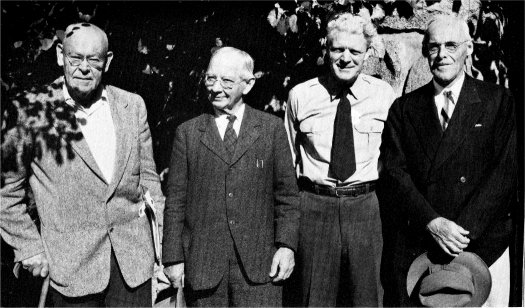
[click to enlarge]
Yosemite Advisory Board, 1953, with Supt. John C. Preston
l. to r., W. E. Colby, F. L. Olmsted, Mr. Preston, J. P. Buwalda
| Online Library: | Title | Author | California | Geology | History | Indians | Muir | Mountaineering | Nature | Management |
Yosemite > Library > Tioga Road > Reconstruction >
Next: Post War Development • Contents • Previous: Automobiles Arrive

[click to enlarge] Yosemite Advisory Board, 1953, with Supt. John C. Preston l. to r., W. E. Colby, F. L. Olmsted, Mr. Preston, J. P. Buwalda |
As early as 1925 consideration had been given to realignment and reconstruction of the Tioga Road. In that year Director Mather visited Yosemite to walk-out suggested routes with Park Superintendent Washington B. Lewis. (103) In the years following, various routes were studied and rejected, with the Park Service submitting each for detailed review by conservationists, engineers and other interested groups.
Among the consulting groups was the Yosemite Advisory Board whose three members were imminently qualified to pass judgement on the various proposals. Chairman of the Board Frederic Law Olmsted, whose father, the “Father of American Landscape Architecture,” was instrumental in the setting aside of the Yosemite Grant, was in his own right a world famed landscape architect, an expert on parks and park development and former director of the California State Park Survey. (A prominent overlook on the new road has been called Olmsted View.) The second member of the Board, Duncan McDuffie, had served as Chairman of the California State Parks Council, was past president of the Sierra Club and recipient of the Cornelius Amory Pugsley medal for American Scenic and Historic Preservation. Professor John P. Buwalda, geologist and departmental chairman at California Institute of Technology, was the member of the group perhaps best able to advise on the Yosemite landscape, having done considerable scientific study in the area.
In 1932 a preliminary field survey was made with the tentative route marked and declared open for inspection. Several field trips were made by interested groups and by 1935 there was general agreement, including the concurrence of the Sierra Club (104), that the present route of the realigned Tioga Road would be the one followed: (See map.)
Meanwhile, work had begun on the eastern and western sections. In 1932 contracts were awarded for construction of the Tioga Pass to Fairview Dome section. Funds for the job, $250,000, were allocated from monies received from San Francisco as “rental” for the Hetch Hetchy area. (106) Fifty thousand dollars from the same source was to be made available for the Crane Flat to White Wolf portion, with work to begin in the spring of 1935. (107)
Paving of the 11.6 mile stretch of the new Tioga Road from Cathedral Creek through Tuolumne Meadows to Tioga Pass was completed in the fall of 1937 and for the first time in its history the one-time wagon road had a dustless section. (108) During 1938 the 21 mile McSwain Meadow (White Wolf intersection) to Cathedral Peak section of the unchanged bed of the Great Sierra Wagon Road was oiled for the first time, (109) and with the completion of 14.5 miles of new road between Crane Flat and McSwain Meadows on July 18, 1939, an era had ended. (110) Although nearly a quarter-century would elapse before the 21 mile central section of the old road was replaced, clouds of dust no longer obscured the vistas or irritated the adventuresome motorist.
Clouds of a different sort appeared on the horizon. World War II brought to a halt the further development of the road. Lack of maintenance funds during wartime caused the closing to the public of the Aspen Valley section of the old road.
A couple of “war stories” bear repeating. After the road was closed for the winter in 1942, a man with his wife and three children managed to plow his car through the drifts, after breaking the Tioga Pass gate. He was met by a ranger at Crane Flat and it was decided the best course of action for disobeying the road closure was to have the visitor return to the pass in his own car and repair the gate, a round-trip of 148 miles. “The visitor had intended to drive through the park without stopping, but he became so delighted with the trip back over the Tioga Road that he decided to stay in the park for several days longer. Ranger Givens, who accompanied the man to Tioga Pass, states that the man was a real lover of the mountains and that he enjoyed his punishment immensely. Not only was he taught respect for park regulations, but it is certain that this punishment left nothing but good will for the Park Service in his mind.” (111)
After a hiatus of more than 50 years, cattle again were driven over the Tioga Road in 1943. Permission had been granted because rubber and gasoline shortages made truck transportation of the Aspen Valley herds an impossibility. (112)
Next: Post War Development • Contents • Previous: Automobiles Arrive
| Online Library: | Title | Author | California | Geology | History | Indians | Muir | Mountaineering | Nature | Management |
http://www.yosemite.ca.us/library/tioga_road/reconstruction.html